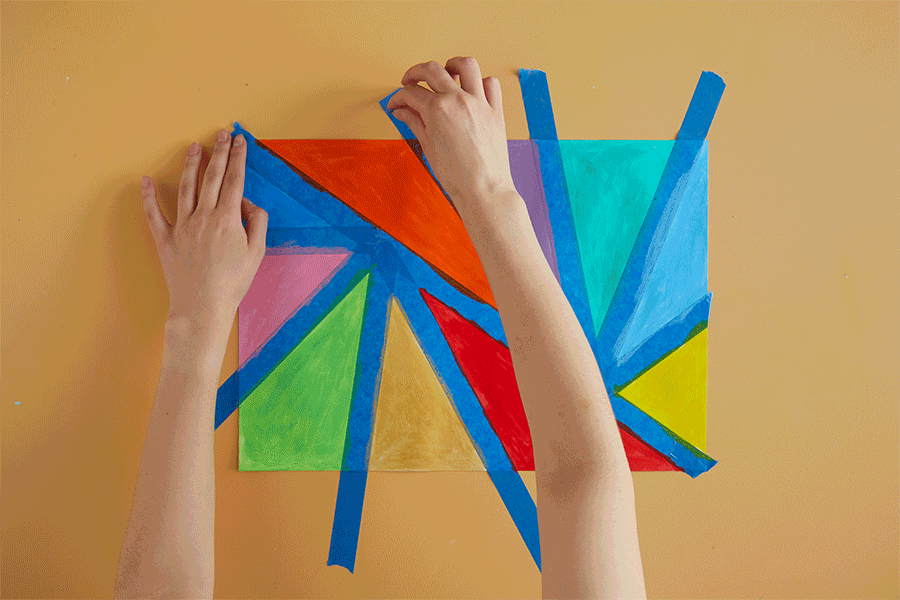Tape art is a great way to introduce a new style of creativity to your kids. It’s a step up from regular freehand drawing or painting, as it uses tape to create shapes and lines on paper that’s then painted over and pulled off at the end.
Tape art is also a creative way to add in some teachable moments about STEM, including mathematical concepts like lines, shapes and angles. You only need a handful of inexpensive craft supplies, such as paint sticks, thick card and masking tape.
Creating tape art with your child is on the easier scale of setup and execution – anyone can do it, even if the extent of your artistic side is drawing stick men. It’s also an opportunity to support your child’s development in a fun and engaging way. “Visual art is great for children; they’re using fine motor skills, gross motor skills, communication [and] hand-eye coordination,” says Roisin McKevitt, centre director at Papilio Early Learning Rosebery and a certified early childhood educator.
Your child will love the sensory experience of placing the masking tape down, pulling it up again and feeling the different textures as they move the paint sticks over the painting tape and card. Plus, using paint sticks rather than liquid paint also means this activity has less clean-up for you.
SEE ALSO: Saw It on Social: Your Favourite Early Learning Finds

How Tape Art Encourages Sensory Play
There are many different sensory aspects to tape art, especially when using masking tape, says Roisin. “It’s a sensory tool – it’s sticky. It gives them an insight into different sensory feelings when they're painting over the tape. It's not going to be as smooth as the paper, for example. If they then wanted to rip the tape off the end, it's another sensory tool where they're getting that pulling effect rather than placing it on the card and pushing it down.
Tape Art Introduces Early Mathematical Concepts
Tape artwork is a fun and relaxed early introduction to basic mathematics concepts like shapes and angles as well as symmetry and pattern recognition. Allow your preschooler to explore how shapes can change, for instance, by placing a piece of tape horizontally through a square or rectangle to create two triangles. Let your child place their own pieces of tape and encourage them to name the new shapes they create.
Simple experiences like using materials out of their usual context are also a great learning experience for kids. They may associate tape with fixing things like a tear in a book page, so using it as part of a painting activity broadens their understanding of how materials can be used and function.
SEE ALSO: Easy DIY Sensory Play: Dinosaur Soup Water Play

What You’ll Need
- Liviano A3 Colour Card 300gsm White 5 Pack
- Liviano A2 Colour Card 300gsm White
- PPS Masking Tape 18mm x 50M
- Kadink Paint Sticks Bright 12 Pack
- Kadink Paint Stick Pastel 8 Pack
- Kadink Paint Stick Metal 8 Pack
Instructions
Suitable for Ages 3+ (some adult supervision recommended)

Step 1: Place the white card on a flat surface and position it so it’s easy for kids to reach all sides.
Step 2: Choose your geometric shapes or pattern. This is a great opportunity to discuss with kids the basic shapes they can create with the tape, such as triangles, squares and rectangles. Encourage kids to name the shapes they want to make and help them use strips of tape to mark the outlines of the shapes. Older kids may want to place the tape themselves, while younger kids may need assistance.

Step 3: Help kids choose the paint sticks they’ll use to colour in the shapes. Kids can create colour blocks with primary colours or use metallic or pastel paint sticks to add fun details.
Step 4: Allow paint to dry overnight.
SEE ALSO: Dot Sticker Art Activities for Kids

Step 5: Help kids to carefully peel the tape off the card to reveal their geometric masterpiece. Add a frame and display it proudly on the wall, help kids to turn it into a one-of-a-kind card for someone special or laminate it to create a colourful placemat.







